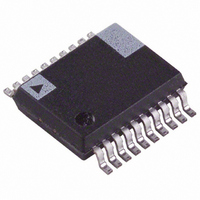ADE7753ARSZ Analog Devices Inc, ADE7753ARSZ Datasheet - Page 39

ADE7753ARSZ
Manufacturer Part Number
ADE7753ARSZ
Description
IC ENERGY METERING 1PHASE 20SSOP
Manufacturer
Analog Devices Inc
Datasheet
1.ADE7753ARSZ.pdf
(60 pages)
Specifications of ADE7753ARSZ
Input Impedance
390 KOhm
Measurement Error
0.1%
Voltage - I/o High
2.4V
Voltage - I/o Low
0.8V
Current - Supply
3mA
Voltage - Supply
4.75 V ~ 5.25 V
Operating Temperature
-40°C ~ 85°C
Mounting Type
Surface Mount
Package / Case
20-SSOP (0.200", 5.30mm Width)
Meter Type
Single Phase
Ic Function
Single-Phase Multifunction Metering IC
Supply Voltage Range
4.75V To 5.25V
Operating Temperature Range
-40°C To +85°C
Digital Ic Case Style
SSOP
No. Of Pins
20
Lead Free Status / RoHS Status
Lead free / RoHS Compliant
For Use With
EVAL-ADE7753ZEB - BOARD EVALUATION AD7753
Lead Free Status / RoHS Status
Lead free / RoHS Compliant, Lead free / RoHS Compliant
Available stocks
Company
Part Number
Manufacturer
Quantity
Price
Part Number:
ADE7753ARSZ
Manufacturer:
ADI/亚德诺
Quantity:
20 000
Part Number:
ADE7753ARSZRL
Manufacturer:
ADI/亚德诺
Quantity:
20 000
The nominal CF on a sample set of meters should be measured
using the default CFDEN, CFNUM, and WDIV to ensure that
the best CFDEN is chosen for the design.
With the CFNUM register set to 0, CFDEN is calculated to be
489 for the example meter:
This value for CFDEN should be loaded into each meter before
calibration. The WGAIN and WDIV registers can then be used
to finely calibrate the CF output. The following sections explain
how to calibrate a meter based on ADE7753 when using a
reference meter or an accurate source.
Calibrating Watt Gain Using a Reference Meter Example
The CFDEN and CFNUM values for the design should be
written to their respective registers before beginning the
calibration steps shown in Figure 80. When using a reference
meter, the %ERROR in CF is measured by comparing the CF
output of the ADE7753 meter with the pulse output of the
reference meter with the same test conditions applied to both
meters. Equation 45 defines the percent error with respect to
the pulse outputs of both meters (using the base current, I
CFDEN =
CFDEN =
%ERROR
Figure 80. Calibrating Watt Gain Using a Reference Meter
CF(IB)
WRITE CFDEN VALUE TO CFDEN REGISTER
INT
INT
CALCULATE CFDEN VALUE FOR DESIGN
CALCULATE WGAIN. SEE EQUATION 46.
WRITE WGAIN VALUE TO THE WGAIN
MEASURE THE % ERROR BETWEEN
SET I
=
⎛
⎜
⎜
⎝
⎛
⎜
⎝
REFERENCE METER OUTPUT
. 1
CF
CF
CF
THE CF OUTPUT AND THE
TEST
958
9556
REGISTER: ADDR. 0x12
ADDR. 0x15 = CFDEN
IB
IB
IB
CF
(
= I
(
expected
−
nominal
ref
b
⎞
⎟
⎠
CF
, V
−
(
TEST
1
IB
ref
=
)
)
)
(
(
= V
⎞
⎟
⎟
⎠
IB
490
−
)
NOM
1
×
−
100
, PF = 1
) 1
=
02875-A-006
489
b
):
(44)
(45)
Rev. A | Page 39 of 60
For this example:
Meter Constant:
CF Numerator:
CF Denominator:
% Error measured at Base Current:
One LSB change in WGAIN changes the active energy registers
and CF by 0.0244%. WGAIN is a signed twos complement
register and can correct for up to a 50% error. Assuming a
−3.07% error, WGAIN is 126:
When CF is calibrated, the AENERGY register has the same
Wh/LSB constant from meter to meter if the meter constant,
WDIV, and the CFNUM/CFDEN ratio remain the same. The
Wh/LSB ratio for this meter is 6.378 × 10
with WDIV at the default value.
Calibrating Watt Gain Using an Accurate Source Example
The CFDEN value calculated using Equation 44 should be
written to the CFDEN register before beginning calibration and
zero should be written to the CFNUM register. First, the line
accumulation mode and the line accumulation interrupt should
be enabled. Next, the number of half line cycles for the energy
accumulation is written to the LINECYC register. This sets the
accumulation time. Reset the interrupt status register and wait for
the line cycle accumulation interrupt. The first line cycle
accumulation results may not have used the accumulation time
set by the LINECYC register and should be discarded. After
resetting the interrupt status register, the following line cycle
readings will be valid. When LINECYC half line cycles have
elapsed, the IRQ pin goes active low and the nominal LAENERGY
with the test current applied can be read. This LAENERGY
value is compared to the expected LAENERGY value to deter-
mine the WGAIN value. If apparent energy gain calibration is
performed at the same time, LVAENERGY can be read directly
after LAENERGY. Both registers should be read before the next
interrupt is issued on the IRQ pin. Refer to the Apparent Energy
Calculation section for more details. Figure 81 details the steps
that calibrate the watt gain using an accurate source.
WGAIN = INT
WGAIN = INT
Wh
Wh
LSB
LSB
=
=
MeterConst
. 3
(
(
CFNUM
200
CFDEN
(
490
⎛
⎜
⎜
⎝
⎛
⎜
⎝
−
imp/Wh
−
1
%
+
. 0
−
) 1
ERROR
. 3
0244
. 0
+
+
07
ant
) 1
MeterConstant(imp/Wh) = 3.2
CFNUM = 0
CFDEN = 489
%ERROR
0244
) 1
%
%
(imp/Wh)
=
×
CF
WDIV
490
⎞
⎟
⎠
%
=
( IB
126
1
×
CF(IB)
)
3
⎞
⎟
⎟
⎠
2 .
−4
=
= -3.07%
using Equation 39
. 6
378
×
ADE7753
10
−
4
(46)













